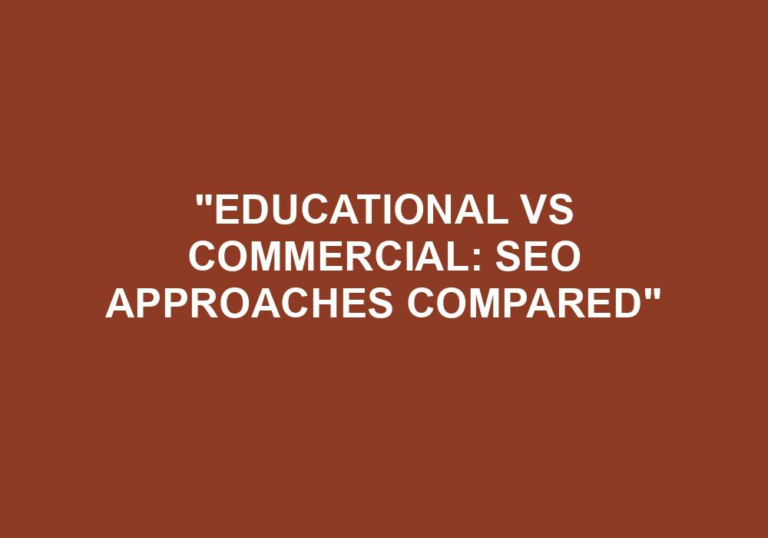Are you ready to dive into the fascinating world of the Headless Web? Get ready because we’re about to explore the SEO implications you need to know! ????????
Welcome, fellow explorer! Today, we’re embarking on a journey through the vast and ever-evolving landscape of the Headless Web. But what exactly is it? In simple terms, the Headless Web refers to websites that separate the backend (server-side) and frontend (client-side) components. It’s like dividing the brain from the body, allowing for more flexibility and dynamic user experiences. ????????
But why does this matter for SEO? That’s where the excitement begins! Navigating the Headless Web comes with its unique SEO implications, and understanding them is vital for website owners, marketers, and anyone venturing into the digital realm. So, buckle up, and let’s uncover the secrets of optimizing your online presence in this headless wonderland! ????✨
The headless web refers to websites built using a decoupled frontend and backend, enabling more versatility. When it comes to SEO implications, there are some key points to know. Firstly, ensure that your website generates static HTML pages for search engine crawlers. Secondly, implement proper metadata tags and structured data for improved visibility. Thirdly, focus on fast loading times and mobile-friendliness. Lastly, monitor and optimize your website’s performance regularly. Stay ahead in the headless web game with these SEO insights!
Navigating the Headless Web: SEO Implications to Know
Welcome to our in-depth guide on navigating the headless web and understanding its SEO implications. In this article, we will explore what the headless web is, how it impacts SEO practices, and provide tips on effectively optimizing your website in this new paradigm.
What is the Headless Web?
The headless web refers to a web development architecture where the front-end and back-end of a website are decoupled, allowing for greater flexibility in delivering content and improving user experiences. In this setup, the front-end, or the “head,” consists of the client-side code responsible for rendering the user interface, while the back-end handles data management, APIs, and business logic.
By decoupling the front-end and back-end, developers can leverage various technologies, frameworks, and programming languages to build highly customizable and scalable websites. This approach enables the delivery of content across multiple platforms and devices, providing a seamless experience for users.
However, this shift towards the headless web brings about new challenges and considerations for SEO practitioners. Let’s delve into the SEO implications of navigating the headless web.
1. Structured Data and SEO
Structured data plays a crucial role in SEO, enhancing the visibility and understanding of your website’s content by search engines. In a headless architecture, structured data becomes even more important. Since the front-end and back-end are decoupled, the responsibility of implementing structured data falls on the developer, requiring a deeper understanding of the schema vocabulary and its proper implementation.
When implementing structured data in a headless setup, it’s essential to ensure that the data aligns with the content rendered on each page. This can be challenging as dynamic content may change frequently or load asynchronously. Therefore, developers must meticulously synchronize the structured data with the actual content to maintain its relevance and accuracy for search engines.
Additionally, due to the decoupled nature of the headless web, it’s crucial to manage structured data across different platforms or devices, ensuring consistent implementation and accurate representation of your website’s content. Failure to do so may result in inconsistent or incomplete structured data, negatively impacting SEO performance.
2. Page Load Speed and User Experience
In the headless web architecture, front-end rendering is handled separately from data retrieval and processing. While this separation allows for greater customization and faster development cycles, it can also impact page load speed and user experience.
When optimizing for SEO on the headless web, it’s essential to prioritize page load speed. Slow page load times have been shown to negatively impact user engagement and search engine rankings. With a decoupled architecture, developers need to ensure efficient data retrieval, minimize network requests, and optimize resource loading to deliver fast-loading pages.
Furthermore, user experience is a critical factor for SEO success. In a headless setup, the front-end development team plays a vital role in crafting intuitive and engaging user interfaces that provide seamless navigation and interaction. A well-designed front-end experience not only enhances user satisfaction but also contributes to improved metrics such as low bounce rates and increased session durations, signaling the quality of your website to search engines.
3. Mobile Responsiveness and Cross-Platform Support
In today’s digital landscape, mobile responsiveness and cross-platform support are essential for SEO success. With the headless web, the decoupled architecture inherently supports mobile responsiveness, allowing developers to optimize the front-end code specifically for mobile devices.
By leveraging responsive design techniques and ensuring smooth rendering across various screen sizes, you can provide users with a consistent experience, regardless of the device they are using. This is crucial as search engines consider mobile-friendliness as a ranking factor, and a poor mobile experience can significantly impact your SEO performance.
Moreover, the headless web’s flexibility empowers businesses to extend their online presence across multiple platforms, such as smart TVs, wearables, and voice assistants. By tailoring the front-end code to support different platforms, you can tap into new audiences and expand your reach. However, it’s important to note that optimizing for cross-platform compatibility requires careful planning, testing, and ongoing maintenance.
Best Practices for Navigating the Headless Web: SEO Tips
Navigating the headless web can be a challenging endeavor, but with the right strategies, you can effectively optimize your website for SEO. Here are some best practices to consider:
1. Ensure a Seamless Content Strategy
In a headless architecture, your content strategy needs to align with the front-end rendering. It’s crucial to plan and structure your content to ensure that it can be easily retrieved and displayed properly on your website. By organizing your content in a logical and consistent manner, you enhance its SEO visibility and provide a seamless user experience.
Consider implementing a content management system (CMS) that integrates well with your headless architecture. This will allow you to efficiently manage and distribute your content across different platforms, ensuring consistency and accuracy.
Furthermore, regularly audit and update your content to keep it fresh and relevant. Engaging and up-to-date content not only appeals to users but also signals to search engines that your website is authoritative and worthy of higher rankings.
2. Implement Structured Data Correctly
As mentioned earlier, structured data is a critical component of SEO success in the headless web. Take the time to understand the schema vocabulary and implement structured data correctly across your website. Ensure that the data accurately reflects the content displayed on each page, considering any dynamic or asynchronously loaded content.
Utilize Google’s Structured Data Testing Tool to validate your implementation and identify any errors or warnings. Regularly monitor and update your structured data to maintain its relevance and effectiveness.
Consider using a headless CMS that provides built-in support for structured data implementation. This can simplify the process and ensure consistent and accurate structured data across your website.
3. Prioritize Page Load Speed and Performance
Page load speed is crucial for both user experience and SEO. Optimize your website’s performance by minimizing network requests, leveraging caching mechanisms, compressing and optimizing images, and reducing the size of files and resources.
Regularly test and monitor your website’s performance using tools like Google PageSpeed Insights and GTmetrix. Identify and address any performance bottlenecks to deliver fast and responsive pages to your users.
Consider utilizing a content delivery network (CDN) to distribute your website’s assets across multiple servers geographically. This can improve load times by reducing latency for users accessing your website from different locations.
4. Leverage Social Media and Backlinking
Social media and backlinking are essential components of off-page SEO. Actively promote your website’s content on social media platforms to increase visibility and drive organic traffic. Encourage social sharing and engagement to amplify your content’s reach.
Additionally, focus on building high-quality backlinks from relevant and authoritative websites in your industry. Guest posting, influencer collaborations, and partnerships can help you establish a strong backlink profile, signaling to search engines the credibility and relevance of your website.
Regularly monitor your backlink profile using tools like Moz or Ahrefs. Identify any toxic or low-quality backlinks and disavow them to prevent any negative impact on your SEO performance.
Conclusion
Navigating the headless web can be a challenging task for SEO practitioners, but understanding its implications and implementing the right strategies will help you effectively optimize your website for higher rankings and improved user experiences. Remember to prioritize structured data, page load speed, mobile responsiveness, and content strategy to stay ahead in the ever-evolving digital landscape.
Key Takeaways
- Navigating the headless web can have implications on SEO rankings.
- Understanding the concept of the headless web is crucial for effective SEO strategies.
- Creating a seamless user experience across devices is a key consideration for optimizing SEO in the headless web.
- Implementing structured data markup can enhance search engine visibility and improve SEO performance.
- Regularly monitoring and analyzing website performance metrics is essential in maintaining competitive SEO rankings on the headless web.
Frequently Asked Questions
In the world of web development, the rise of headless websites has brought about new challenges and implications for SEO. Navigating this landscape can be tricky, but here are some key questions and answers to help you understand the SEO implications of the headless web.
1. How does a headless website impact SEO?
A headless website separates the front-end and back-end components, meaning that the content presentation layer is decoupled from the content management system. While this allows for more flexibility and faster development, it can have SEO implications. Search engines rely on crawling and indexing the HTML content of a website, which may be more challenging with a headless setup. However, with proper configuration and implementation, headless websites can still achieve good SEO performance. It’s important to focus on server-side rendering, dynamic rendering, or pre-rendering techniques to ensure that search engines can access and index your content effectively.
Additionally, ensuring proper metadata, structured data, and canonical tags are in place is crucial for optimizing a headless website for search engines. These tags help provide context to search engines, making it easier for them to understand and rank your website’s content. Regular monitoring and testing of your website’s SEO performance are also essential to identify and address any potential issues that might arise with a headless setup.
2. Does a headless CMS affect keyword optimization?
A headless CMS, by nature, focuses more on content management rather than presentation. This means that the keyword optimization process may differ from traditional CMS setups. In a headless CMS, you have more control over how your content is structured and presented across various platforms and devices. This allows for a more tailored and targeted keyword optimization strategy.
With a headless CMS, you can create content modules or components that can be reused and adapted to different layouts and interfaces. This flexibility enables you to optimize keywords specifically for different sections or areas of your website, ensuring that your content is relevant and valuable to your target audience. By utilizing analytics and performance data, you can also refine your keyword strategy over time to improve SEO outcomes on your headless website.
3. What are the advantages of using a headless web architecture for SEO?
One of the significant advantages of a headless web architecture for SEO is the improved website performance and loading speed. By separating the front-end presentation layer from the back-end content management system, you can optimize each component independently. This allows for faster loading times, which is a critical factor in search engine rankings. Search engines prioritize websites that offer a seamless and fast user experience.
Additionally, a headless web architecture provides more flexibility in terms of content customization and personalization. You can tailor the content and user experience based on the device type, location, or user preferences. This level of personalization can result in higher engagement and better user satisfaction, both of which are crucial for SEO success.
4. How does mobile optimization play a role in the headless web and SEO?
Mobile optimization is a vital aspect of both the headless web and SEO. With the increasing use of mobile devices for web browsing, search engines prioritize websites that provide an optimal experience on mobile. A headless architecture allows you to focus specifically on mobile optimization by ensuring that your website is responsive and fast on mobile devices.
As mobile users have different browsing behaviors and expectations, you can adapt your content and user interface to suit their needs. This may involve creating mobile-specific layouts, optimizing images and media for mobile screens, and implementing mobile-friendly navigation. By prioritizing mobile optimization in a headless setup, you can improve your website’s visibility and rankings on mobile search results.
5. How can I overcome SEO challenges in a headless web environment?
To overcome SEO challenges in a headless web environment, it’s crucial to have a solid technical foundation. Implementing server-side rendering or dynamic rendering techniques ensures that search engines can crawl and index your website effectively. Pre-rendering content can also be beneficial, as it allows search engines to access a fully rendered version of your website.
Furthermore, proper implementation of metadata, structured data, and canonical tags is essential. These elements provide crucial information to search engines and improve the visibility and relevance of your website in search results. Regular monitoring of your website’s SEO performance, conducting technical audits, and staying up-to-date with the latest SEO best practices for headless websites will also help you navigate and overcome any SEO challenges that arise.
Summary
The headless web is when websites are built without a traditional “head” containing HTML code. This can make it harder for search engines to understand and rank websites. To optimize your headless website for SEO, follow these tips:
First, make sure you have a sitemap, as this helps search engines find and index your pages. Next, focus on on-page optimization by including relevant keywords in your content. Additionally, use descriptive meta tags and page titles to provide information to search engines. Lastly, consider implementing structured data to make it easier for search engines to understand your website’s content.
Remember, even though headless websites may present some challenges, by following these SEO practices, you can improve your website’s visibility and rankings on search engines.





